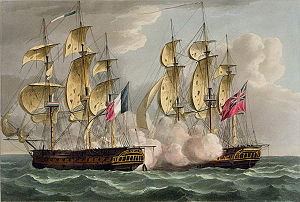Name Résistance Laid down April 1794 In service May 1796 Draft 6.4 m | Builder Paimbœuf Launched 28 November 1795 Length 49 m | |
 | ||
Captured 9 March 1797, by the Royal Navy | ||
Résistance was a Vengeance-class frigate of the French Navy. She was captured by HMS St Fiorenzo in 1797 and taken into British service as HMS Fisgard. She was sold in 1814.
Contents
French career
The ship ordered on 8 March 1793 as Fidélité, was renamed Résistance while still on keel. In 1797 she served as a troop ship, ferrying the Légion Noire to Cardigan Bay during the Battle of Fishguard. On 9 March 1797, HMS St Fiorenzo and Nymphe, captured her, along with Constance.
British career
The Royal Navy took Résistance into service as the first HMS Fisgard, naming her after the town of Fishguard because of her role in the battle. On 20 October 1798, she captured Immortalité.
Between 20 July 1800 and 2 August, Captain T.B. Martin and Fisgard captured four vessels:
Fisgard may also have recaptured four of Gironde's prizes:
On 15 May 1801 Fisgard, and the hired armed cutters Hirondelle and Earl Spencer, recaptured the brig Victory from the French. Then on 7 July Fisgard was at Plymouth when the gun-vessel HMS Augustus ran aground under the Royal Citadel, Plymouth. Fisgard sent her boats to assist and the crew and some of the stores were saved, but the vessel herself was a wreck.
Fate
The Principal Officers and Commissioners of the Royal Navy offered "Fisgard, of 38 guns and 1182 tons", lying at Portsmouth, for sale on 11 August 1814. The buyer had to post a bond of £3,000, with two guarantors, that the buyers would break up the vessel within a year of purchase.
